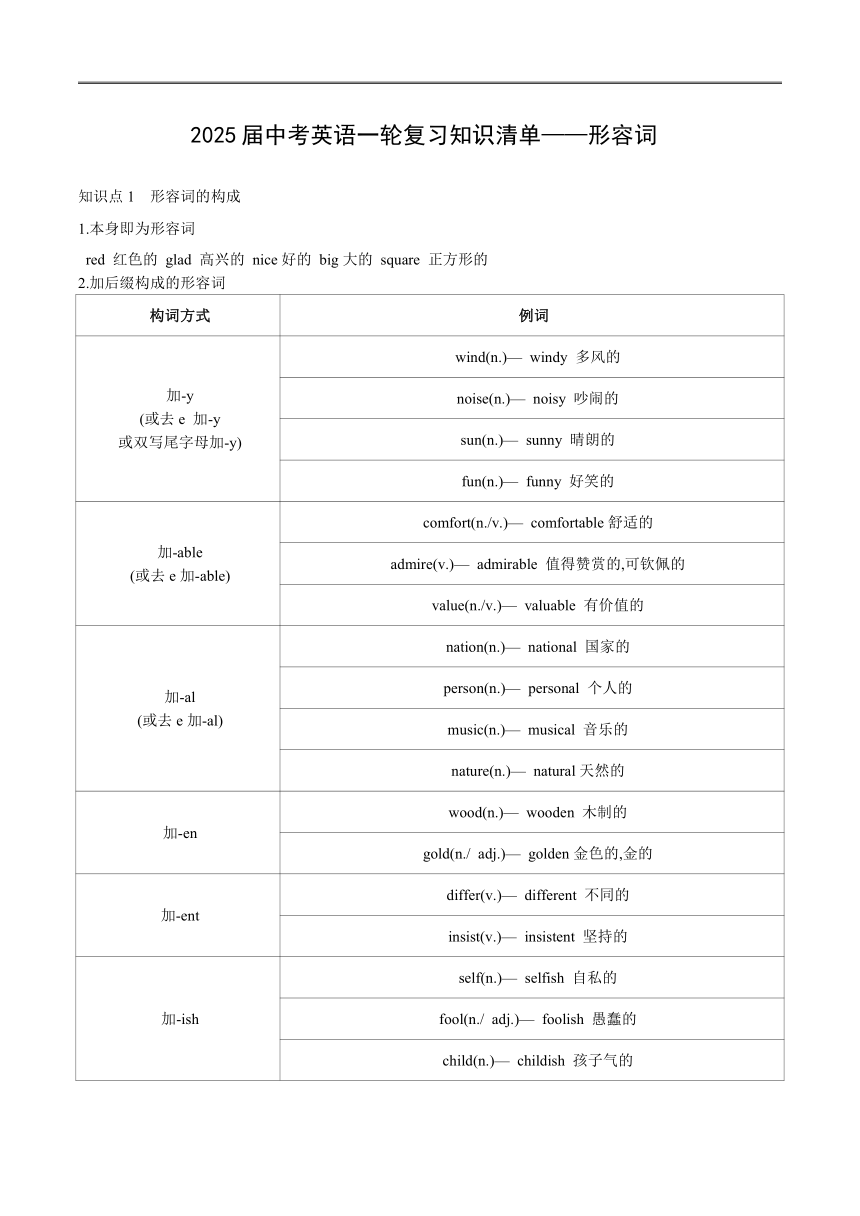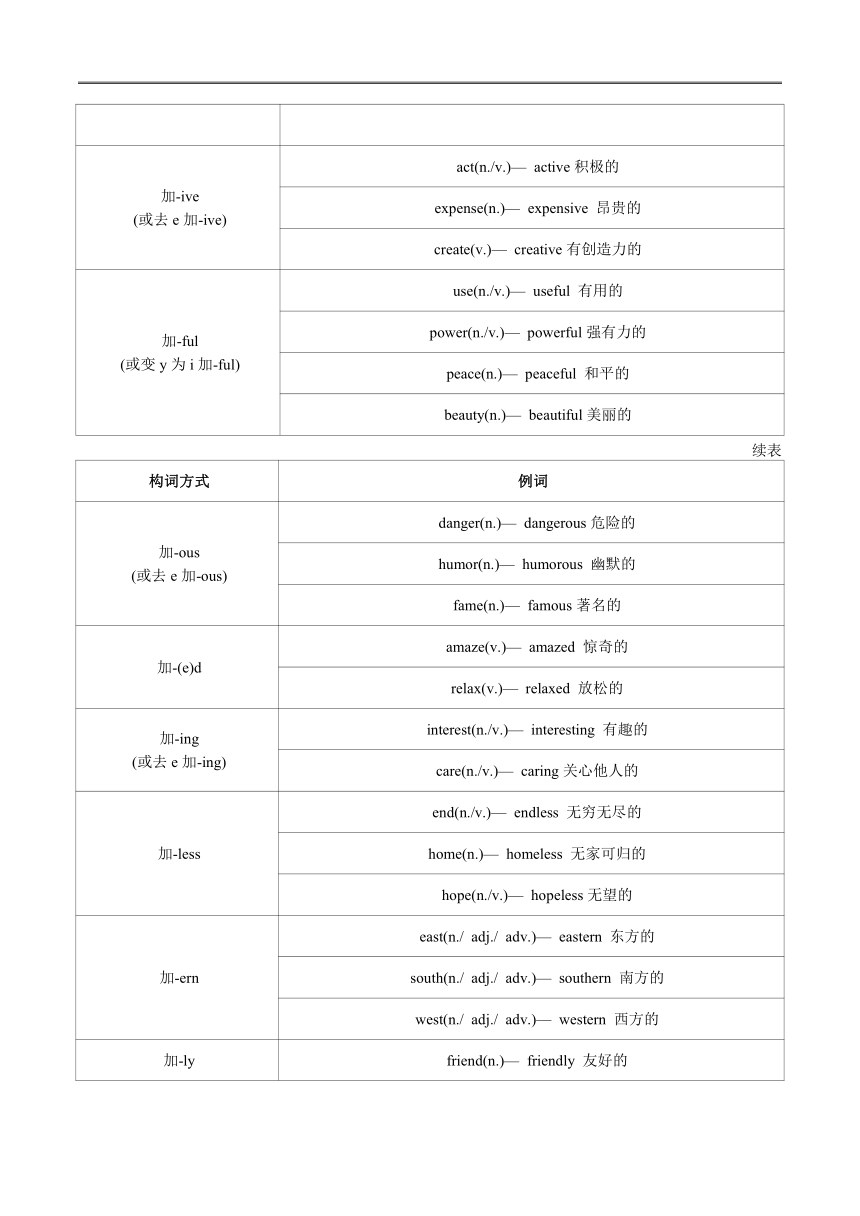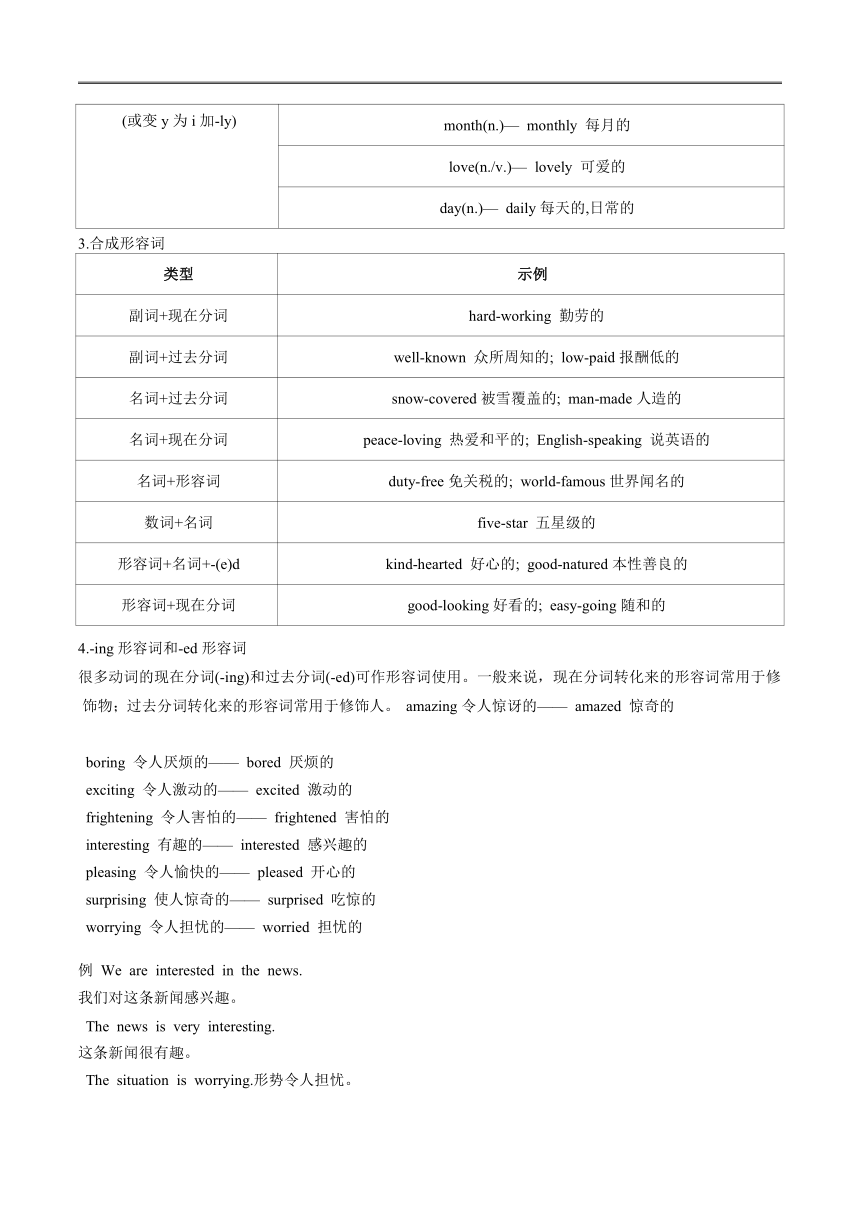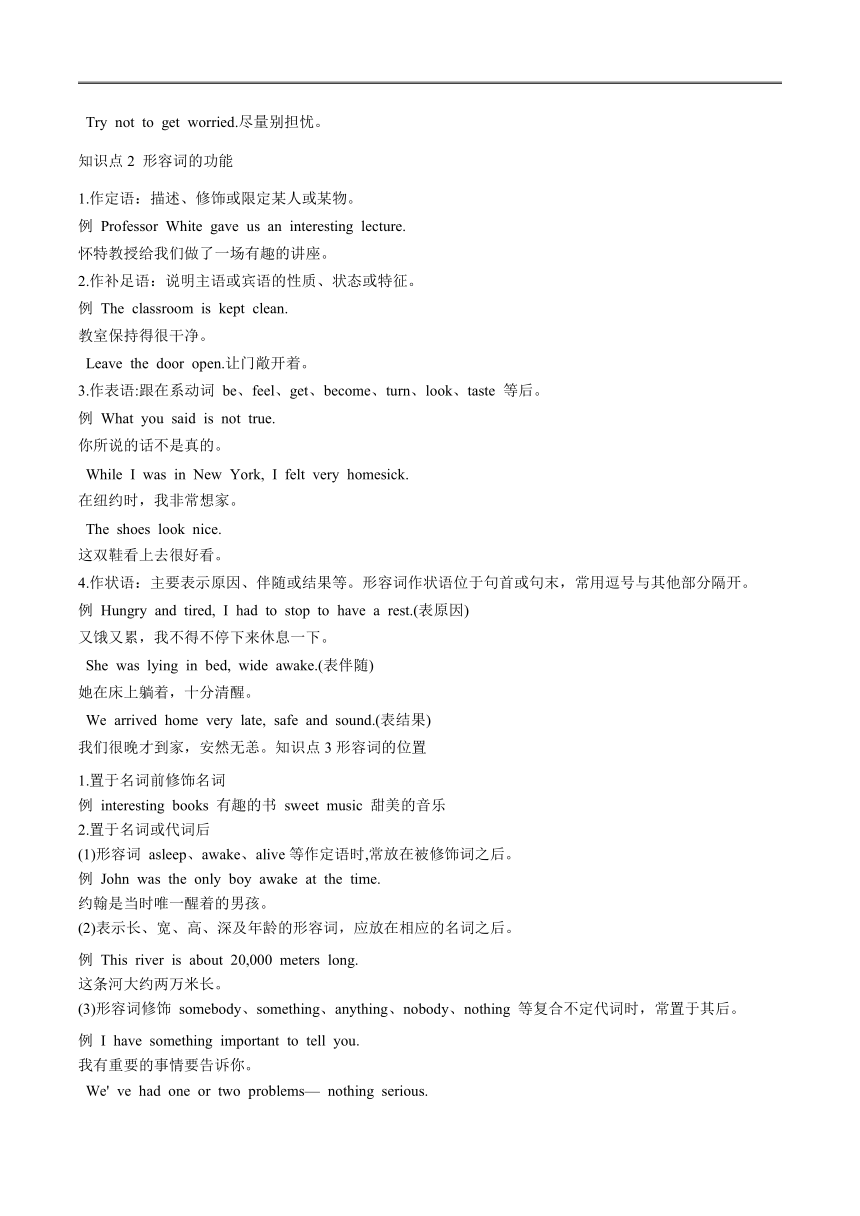2025年中考英语一轮复习知识清单——形容词
文档属性
| 名称 | 2025年中考英语一轮复习知识清单——形容词 |  | |
| 格式 | docx | ||
| 文件大小 | 254.6KB | ||
| 资源类型 | 教案 | ||
| 版本资源 | 通用版 | ||
| 科目 | 英语 | ||
| 更新时间 | 2024-11-25 19:20:17 | ||
图片预览




文档简介
2025届中考英语一轮复习知识清单——形容词
知识点1 形容词的构成
1.本身即为形容词
red 红色的 glad 高兴的 nice好的 big大的 square 正方形的
2.加后缀构成的形容词
构词方式 例词
加-y (或去e 加-y 或双写尾字母加-y) wind(n.)— windy 多风的
noise(n.)— noisy 吵闹的
sun(n.)— sunny 晴朗的
fun(n.)— funny 好笑的
加-able (或去e加-able) comfort(n./v.)— comfortable舒适的
admire(v.)— admirable 值得赞赏的,可钦佩的
value(n./v.)— valuable 有价值的
加-al (或去e加-al) nation(n.)— national 国家的
person(n.)— personal 个人的
music(n.)— musical 音乐的
nature(n.)— natural天然的
加-en wood(n.)— wooden 木制的
gold(n./ adj.)— golden金色的,金的
加-ent differ(v.)— different 不同的
insist(v.)— insistent 坚持的
加-ish self(n.)— selfish 自私的
fool(n./ adj.)— foolish 愚蠢的
child(n.)— childish 孩子气的
加-ive (或去e加-ive) act(n./v.)— active积极的
expense(n.)— expensive 昂贵的
create(v.)— creative有创造力的
加-ful (或变y为i加-ful) use(n./v.)— useful 有用的
power(n./v.)— powerful强有力的
peace(n.)— peaceful 和平的
beauty(n.)— beautiful美丽的
续表
构词方式 例词
加-ous (或去e加-ous) danger(n.)— dangerous危险的
humor(n.)— humorous 幽默的
fame(n.)— famous著名的
加-(e)d amaze(v.)— amazed 惊奇的
relax(v.)— relaxed 放松的
加-ing (或去e加-ing) interest(n./v.)— interesting 有趣的
care(n./v.)— caring关心他人的
加-less end(n./v.)— endless 无穷无尽的
home(n.)— homeless 无家可归的
hope(n./v.)— hopeless无望的
加-ern east(n./ adj./ adv.)— eastern 东方的
south(n./ adj./ adv.)— southern 南方的
west(n./ adj./ adv.)— western 西方的
加-ly (或变y为i加-ly) friend(n.)— friendly 友好的
month(n.)— monthly 每月的
love(n./v.)— lovely 可爱的
day(n.)— daily每天的,日常的
3.合成形容词
类型 示例
副词+现在分词 hard-working 勤劳的
副词+过去分词 well-known 众所周知的; low-paid报酬低的
名词+过去分词 snow-covered被雪覆盖的; man-made人造的
名词+现在分词 peace-loving 热爱和平的; English-speaking 说英语的
名词+形容词 duty-free免关税的; world-famous世界闻名的
数词+名词 five-star 五星级的
形容词+名词+-(e)d kind-hearted 好心的; good-natured本性善良的
形容词+现在分词 good-looking好看的; easy-going随和的
4.-ing形容词和-ed形容词
很多动词的现在分词(-ing)和过去分词(-ed)可作形容词使用。一般来说,现在分词转化来的形容词常用于修饰物;过去分词转化来的形容词常用于修饰人。 amazing令人惊讶的—— amazed 惊奇的
boring 令人厌烦的—— bored 厌烦的
exciting 令人激动的—— excited 激动的
frightening 令人害怕的—— frightened 害怕的
interesting 有趣的—— interested 感兴趣的
pleasing 令人愉快的—— pleased 开心的
surprising 使人惊奇的—— surprised 吃惊的
worrying 令人担忧的—— worried 担忧的
例 We are interested in the news.
我们对这条新闻感兴趣。
The news is very interesting.
这条新闻很有趣。
The situation is worrying.形势令人担忧。
Try not to get worried.尽量别担忧。
知识点2 形容词的功能
1.作定语:描述、修饰或限定某人或某物。
例 Professor White gave us an interesting lecture.
怀特教授给我们做了一场有趣的讲座。
2.作补足语:说明主语或宾语的性质、状态或特征。
例 The classroom is kept clean.
教室保持得很干净。
Leave the door open.让门敞开着。
3.作表语:跟在系动词 be、feel、get、become、turn、look、taste 等后。
例 What you said is not true.
你所说的话不是真的。
While I was in New York, I felt very homesick.
在纽约时,我非常想家。
The shoes look nice.
这双鞋看上去很好看。
4.作状语:主要表示原因、伴随或结果等。形容词作状语位于句首或句末,常用逗号与其他部分隔开。
例 Hungry and tired, I had to stop to have a rest.(表原因)
又饿又累,我不得不停下来休息一下。
She was lying in bed, wide awake.(表伴随)
她在床上躺着,十分清醒。
We arrived home very late, safe and sound.(表结果)
我们很晚才到家,安然无恙。知识点3形容词的位置
1.置于名词前修饰名词
例 interesting books 有趣的书 sweet music 甜美的音乐
2.置于名词或代词后
(1)形容词 asleep、awake、alive等作定语时,常放在被修饰词之后。
例 John was the only boy awake at the time.
约翰是当时唯一醒着的男孩。
(2)表示长、宽、高、深及年龄的形容词,应放在相应的名词之后。
例 This river is about 20,000 meters long.
这条河大约两万米长。
(3)形容词修饰 somebody、something、anything、nobody、nothing 等复合不定代词时,常置于其后。
例 I have something important to tell you.
我有重要的事情要告诉你。
We' ve had one or two problems— nothing serious.
我们有一些问题,不过没什么大不了的。
3.多个形容词修饰同一个名词时的排列顺序(通常如下)
限定词(冠词、所有格、形容词性物主代词等)+序数词+基数词+表示观点的形容词(品质、特性等,即表示好、坏、美、丑等的词)+大小或长短+形状或样式+年龄或新旧+颜色+产地或来源+材料或种类+用途+名词。
例 his new grey shirt 他的灰色新衬衫
ten strong black plastic bags
十个结实的黑色塑料袋
such a pretty long red dress
如此漂亮的一件红色长裙
the third round brown wooden table
第三张褐色圆木桌
both the tall old Russian men 这两个高大的俄罗斯老人
知识点4 形容词的比较等级
1.比较级和最高级的构成
(1)规则变化
构成 原级 比较级 最高级
单 音 节 词 一 般 加-er/-est strong 强壮的 stronger 较强壮的 strongest 最强壮的
以字母 e 结尾只加-r/-st brave 勇敢的 braver 更勇敢的 bravest 最勇敢的
续表
构成 原级 比较级 最高级
以一个辅音字母结尾的重读闭音节词, 双写这一辅音字母再加-er/-est red红色的 fat胖的 hot 热的 thin 瘦的 big大的 wet 潮湿的 redder 更红的 fatter更胖的 hotter更热的 thinner 更瘦的 bigger更大的 wetter 更潮湿的 reddest 最红的 fattest 最胖的 hottest 最热的 thinnest 最瘦的 biggest 最大的 wettest最潮湿的
以“辅音字母+y”结尾, 将y变为i, 再加-er/-est angry 生气的 happy 高兴的 angrier 更生气的 happier 更高兴的 angriest 最生气的 happiest 最高兴的
多音节词和部分双音节词前加 more/ most beautiful 漂亮的 more beautiful更漂亮的 most beautiful最漂亮的
(2)不规则变化
原级 比较级 最高级
good, well better best
bad worse worst
little(少的) less least
much, many more most
far farther/ further farthest/ furthest
old older/ elder oldest/ eldest
(3)“较不和最不”的表达:在形容词前分别加上 less 和 least。
例 hard-working— less hard-working— least hard-working
勤奋的—较不勤奋的—最不勤奋的
shy— less shy— least shy
害羞的—较不害羞的—最不害羞的
2.原级表示比较的用法
(1)肯定句中常用“as+形容词原级+ as”的结构,表示“……(前者)和……(后者)一样……”。
例 Jim is as tall as Mike.吉姆和迈克一样高。
(2)在否定句中,可用“not so/ as+形容词原级+ as”结构,表示“……(前者)不如……(后者)那样……”。
例 My handwriting is not so/ as beautiful as yours.
我的字不如你的漂亮。
Today is not so/ as warm as yesterday.
今天不如昨天暖和。(3)倍数表达用“倍数+ as+形容词原级+ as”结构,表示“……是……的几倍……”。
例 This room is twice as big as that one.
这个房间是那个房间的两倍大。
3.比较级的用法
(1)“比较级+ than”结构表达一方超过或低于另一方的情况。
例 He made fewer mistakes than you ( did).他出的错比你少。
(2)“比较级+ and+比较级”意为“越来越……”,多音节词和部分双音节词用于此结构时,要用“more and more+形容词原级”。
例 My English is getting better and better.
我的英语越来越好了。
Our country is becoming more and more beautiful.
我们的国家正变得越来越美丽。
(3)“the+比较级,the+比较级”表示一方的程度随着另一方程度的变化而变化,意为“越……,(就)越……”。
例 The more difficult the problem is, the more careful we should be.
问题越难,我们就应该越仔细。
(4)“Which/ Who...+比较级,A or B ”表示“A 和 B 哪一个/谁更…… ”。
例 Who is taller, Tom or Jim
汤姆和吉姆谁更高
(5)“A…+倍数+比较级+ than+B”表示“A是B 的几倍……”。
例 This ruler is twice longer than that one.
这把尺子是那把尺子的两倍长。
(6)“A…+ the+比较级+ of the two+可数名词复数”表示“……是两者中较/更……的那个”。
例 Jane is the taller of the two children in our family.
简是我们家两个孩子中较高的那一个。
注意比较的对象或范围
The weather of Beijing is colder than Shanghai.(×)(比较对象错误,句中作比较的是北京的天气和上海的天气。)
The weather of Beijing is colder than that of Shanghai.( )
北京的天气比上海的冷。
China is larger than any country in Asia.(×)(逻辑错误,中国就是亚洲的一个国家,应与亚洲其他国家相比。)
China is larger than any other country in Asia.( )
中国比亚洲其他任何国家都大。
China is larger than any country in Africa.( )
中国比非洲的任何国家都大。
(7)比较级的单独使用:比较级单独使用时,其比较对象暗含于句中。
例 Are you feeling better today 你今天感觉好一些了吗
Be more careful next time.下次更小心一些。
She hoped to get a better job.她希望得到一份更好的工作。
Further discussion will take place tomorrow.
进一步的讨论将于明天进行。
4.最高级的用法
(1)表示三者或三者以上中程度最高。
例 Shanghai is one of the largest cities in China.
上海是中国最大的城市之一。
This TV is the least expensive.这台电视是最便宜的。
(2)最高级前可以没有 the,表示“很”“非常”。
例 This is a most interesting story.这是一个很有趣的故事。
(3)用比较级表示最高级意义。
①比较级+ than+ any other+单数名词
例 Julia is taller than any other girl in her class.
= Julia is the tallest girl in her class.
朱莉娅是她班里最高的女生。
②否定词+比较级
例 I have never heard a better voice than yours.
= Your voice is the best voice that I have ever heard.
你的嗓音是我听过的最好的(嗓音)。
Nothing is more valuable than time.
= Time is the most valuable thing.
时间是最珍贵的东西。
5.比较等级的修饰语
(1)原级的修饰语
almost 几乎 quite 相当 very 很 exactly 恰好
just 刚好,仅仅 too 太 so如此 nearly 几乎
例 He is almost as tall as his father.他几乎和他爸爸一样高。
(2)比较级的修饰语
much 更加 even更,甚至 a little 一点 far 远远,更
a lot很 still 更,还要 a bit有点
例 Our city is much more beautiful than before.
我们的城市比以前漂亮多了。
(3)最高级的修饰语
the+序数词 第……最 much很,非常 almost 几乎
by far 大大地 nearly 几乎 far and away 大大地例 It is the second largest city in China.
它是中国第二大城市。
Of the three girls, Betty is much the cleverest.
这三个女孩中,贝蒂是最聪明的。
知识点5 含形容词的常用句型
1. “it's+ adj.(+ for+ sb.)+动词不定式”或“it is+ adj.+ that 从句”表示“做某事(对某人来说)怎么样”。
例 It is not easy for Jim to learn Chinese.
学汉语对吉姆来说不容易。
It's important that we study hard for the coming exam.
为即将到来的考试努力学习是重要的。
2. “it’ s+ adj.+ of+ sb.+动词不定式”表示“某人做某事怎么样”。
例 It's kind of you to help me.你帮助我太好了。
It's nice of you to say so.你这样说太好了。
3.表示感情或情绪的形容词,如 glad(高兴的)、pleased(高兴的)、 sorry(遗憾的,难过的)、 sad(忧伤的)等后常接动词不定式。
例I'm glad to see you.
见到你我很高兴。
I'm sorry to hear that.
听到那件事我很难过。
4.表示能力和意志的形容词,如 ready(乐意的,有准备的)、able(有能力的)、sure(一定)、certain(一定)等后常接动词不定式。
例 Lei Feng was always ready to help others.
雷锋总是乐于帮助别人。
Are you able to come the day after tomorrow
后天你能来吗
知识点1 形容词的构成
1.本身即为形容词
red 红色的 glad 高兴的 nice好的 big大的 square 正方形的
2.加后缀构成的形容词
构词方式 例词
加-y (或去e 加-y 或双写尾字母加-y) wind(n.)— windy 多风的
noise(n.)— noisy 吵闹的
sun(n.)— sunny 晴朗的
fun(n.)— funny 好笑的
加-able (或去e加-able) comfort(n./v.)— comfortable舒适的
admire(v.)— admirable 值得赞赏的,可钦佩的
value(n./v.)— valuable 有价值的
加-al (或去e加-al) nation(n.)— national 国家的
person(n.)— personal 个人的
music(n.)— musical 音乐的
nature(n.)— natural天然的
加-en wood(n.)— wooden 木制的
gold(n./ adj.)— golden金色的,金的
加-ent differ(v.)— different 不同的
insist(v.)— insistent 坚持的
加-ish self(n.)— selfish 自私的
fool(n./ adj.)— foolish 愚蠢的
child(n.)— childish 孩子气的
加-ive (或去e加-ive) act(n./v.)— active积极的
expense(n.)— expensive 昂贵的
create(v.)— creative有创造力的
加-ful (或变y为i加-ful) use(n./v.)— useful 有用的
power(n./v.)— powerful强有力的
peace(n.)— peaceful 和平的
beauty(n.)— beautiful美丽的
续表
构词方式 例词
加-ous (或去e加-ous) danger(n.)— dangerous危险的
humor(n.)— humorous 幽默的
fame(n.)— famous著名的
加-(e)d amaze(v.)— amazed 惊奇的
relax(v.)— relaxed 放松的
加-ing (或去e加-ing) interest(n./v.)— interesting 有趣的
care(n./v.)— caring关心他人的
加-less end(n./v.)— endless 无穷无尽的
home(n.)— homeless 无家可归的
hope(n./v.)— hopeless无望的
加-ern east(n./ adj./ adv.)— eastern 东方的
south(n./ adj./ adv.)— southern 南方的
west(n./ adj./ adv.)— western 西方的
加-ly (或变y为i加-ly) friend(n.)— friendly 友好的
month(n.)— monthly 每月的
love(n./v.)— lovely 可爱的
day(n.)— daily每天的,日常的
3.合成形容词
类型 示例
副词+现在分词 hard-working 勤劳的
副词+过去分词 well-known 众所周知的; low-paid报酬低的
名词+过去分词 snow-covered被雪覆盖的; man-made人造的
名词+现在分词 peace-loving 热爱和平的; English-speaking 说英语的
名词+形容词 duty-free免关税的; world-famous世界闻名的
数词+名词 five-star 五星级的
形容词+名词+-(e)d kind-hearted 好心的; good-natured本性善良的
形容词+现在分词 good-looking好看的; easy-going随和的
4.-ing形容词和-ed形容词
很多动词的现在分词(-ing)和过去分词(-ed)可作形容词使用。一般来说,现在分词转化来的形容词常用于修饰物;过去分词转化来的形容词常用于修饰人。 amazing令人惊讶的—— amazed 惊奇的
boring 令人厌烦的—— bored 厌烦的
exciting 令人激动的—— excited 激动的
frightening 令人害怕的—— frightened 害怕的
interesting 有趣的—— interested 感兴趣的
pleasing 令人愉快的—— pleased 开心的
surprising 使人惊奇的—— surprised 吃惊的
worrying 令人担忧的—— worried 担忧的
例 We are interested in the news.
我们对这条新闻感兴趣。
The news is very interesting.
这条新闻很有趣。
The situation is worrying.形势令人担忧。
Try not to get worried.尽量别担忧。
知识点2 形容词的功能
1.作定语:描述、修饰或限定某人或某物。
例 Professor White gave us an interesting lecture.
怀特教授给我们做了一场有趣的讲座。
2.作补足语:说明主语或宾语的性质、状态或特征。
例 The classroom is kept clean.
教室保持得很干净。
Leave the door open.让门敞开着。
3.作表语:跟在系动词 be、feel、get、become、turn、look、taste 等后。
例 What you said is not true.
你所说的话不是真的。
While I was in New York, I felt very homesick.
在纽约时,我非常想家。
The shoes look nice.
这双鞋看上去很好看。
4.作状语:主要表示原因、伴随或结果等。形容词作状语位于句首或句末,常用逗号与其他部分隔开。
例 Hungry and tired, I had to stop to have a rest.(表原因)
又饿又累,我不得不停下来休息一下。
She was lying in bed, wide awake.(表伴随)
她在床上躺着,十分清醒。
We arrived home very late, safe and sound.(表结果)
我们很晚才到家,安然无恙。知识点3形容词的位置
1.置于名词前修饰名词
例 interesting books 有趣的书 sweet music 甜美的音乐
2.置于名词或代词后
(1)形容词 asleep、awake、alive等作定语时,常放在被修饰词之后。
例 John was the only boy awake at the time.
约翰是当时唯一醒着的男孩。
(2)表示长、宽、高、深及年龄的形容词,应放在相应的名词之后。
例 This river is about 20,000 meters long.
这条河大约两万米长。
(3)形容词修饰 somebody、something、anything、nobody、nothing 等复合不定代词时,常置于其后。
例 I have something important to tell you.
我有重要的事情要告诉你。
We' ve had one or two problems— nothing serious.
我们有一些问题,不过没什么大不了的。
3.多个形容词修饰同一个名词时的排列顺序(通常如下)
限定词(冠词、所有格、形容词性物主代词等)+序数词+基数词+表示观点的形容词(品质、特性等,即表示好、坏、美、丑等的词)+大小或长短+形状或样式+年龄或新旧+颜色+产地或来源+材料或种类+用途+名词。
例 his new grey shirt 他的灰色新衬衫
ten strong black plastic bags
十个结实的黑色塑料袋
such a pretty long red dress
如此漂亮的一件红色长裙
the third round brown wooden table
第三张褐色圆木桌
both the tall old Russian men 这两个高大的俄罗斯老人
知识点4 形容词的比较等级
1.比较级和最高级的构成
(1)规则变化
构成 原级 比较级 最高级
单 音 节 词 一 般 加-er/-est strong 强壮的 stronger 较强壮的 strongest 最强壮的
以字母 e 结尾只加-r/-st brave 勇敢的 braver 更勇敢的 bravest 最勇敢的
续表
构成 原级 比较级 最高级
以一个辅音字母结尾的重读闭音节词, 双写这一辅音字母再加-er/-est red红色的 fat胖的 hot 热的 thin 瘦的 big大的 wet 潮湿的 redder 更红的 fatter更胖的 hotter更热的 thinner 更瘦的 bigger更大的 wetter 更潮湿的 reddest 最红的 fattest 最胖的 hottest 最热的 thinnest 最瘦的 biggest 最大的 wettest最潮湿的
以“辅音字母+y”结尾, 将y变为i, 再加-er/-est angry 生气的 happy 高兴的 angrier 更生气的 happier 更高兴的 angriest 最生气的 happiest 最高兴的
多音节词和部分双音节词前加 more/ most beautiful 漂亮的 more beautiful更漂亮的 most beautiful最漂亮的
(2)不规则变化
原级 比较级 最高级
good, well better best
bad worse worst
little(少的) less least
much, many more most
far farther/ further farthest/ furthest
old older/ elder oldest/ eldest
(3)“较不和最不”的表达:在形容词前分别加上 less 和 least。
例 hard-working— less hard-working— least hard-working
勤奋的—较不勤奋的—最不勤奋的
shy— less shy— least shy
害羞的—较不害羞的—最不害羞的
2.原级表示比较的用法
(1)肯定句中常用“as+形容词原级+ as”的结构,表示“……(前者)和……(后者)一样……”。
例 Jim is as tall as Mike.吉姆和迈克一样高。
(2)在否定句中,可用“not so/ as+形容词原级+ as”结构,表示“……(前者)不如……(后者)那样……”。
例 My handwriting is not so/ as beautiful as yours.
我的字不如你的漂亮。
Today is not so/ as warm as yesterday.
今天不如昨天暖和。(3)倍数表达用“倍数+ as+形容词原级+ as”结构,表示“……是……的几倍……”。
例 This room is twice as big as that one.
这个房间是那个房间的两倍大。
3.比较级的用法
(1)“比较级+ than”结构表达一方超过或低于另一方的情况。
例 He made fewer mistakes than you ( did).他出的错比你少。
(2)“比较级+ and+比较级”意为“越来越……”,多音节词和部分双音节词用于此结构时,要用“more and more+形容词原级”。
例 My English is getting better and better.
我的英语越来越好了。
Our country is becoming more and more beautiful.
我们的国家正变得越来越美丽。
(3)“the+比较级,the+比较级”表示一方的程度随着另一方程度的变化而变化,意为“越……,(就)越……”。
例 The more difficult the problem is, the more careful we should be.
问题越难,我们就应该越仔细。
(4)“Which/ Who...+比较级,A or B ”表示“A 和 B 哪一个/谁更…… ”。
例 Who is taller, Tom or Jim
汤姆和吉姆谁更高
(5)“A…+倍数+比较级+ than+B”表示“A是B 的几倍……”。
例 This ruler is twice longer than that one.
这把尺子是那把尺子的两倍长。
(6)“A…+ the+比较级+ of the two+可数名词复数”表示“……是两者中较/更……的那个”。
例 Jane is the taller of the two children in our family.
简是我们家两个孩子中较高的那一个。
注意比较的对象或范围
The weather of Beijing is colder than Shanghai.(×)(比较对象错误,句中作比较的是北京的天气和上海的天气。)
The weather of Beijing is colder than that of Shanghai.( )
北京的天气比上海的冷。
China is larger than any country in Asia.(×)(逻辑错误,中国就是亚洲的一个国家,应与亚洲其他国家相比。)
China is larger than any other country in Asia.( )
中国比亚洲其他任何国家都大。
China is larger than any country in Africa.( )
中国比非洲的任何国家都大。
(7)比较级的单独使用:比较级单独使用时,其比较对象暗含于句中。
例 Are you feeling better today 你今天感觉好一些了吗
Be more careful next time.下次更小心一些。
She hoped to get a better job.她希望得到一份更好的工作。
Further discussion will take place tomorrow.
进一步的讨论将于明天进行。
4.最高级的用法
(1)表示三者或三者以上中程度最高。
例 Shanghai is one of the largest cities in China.
上海是中国最大的城市之一。
This TV is the least expensive.这台电视是最便宜的。
(2)最高级前可以没有 the,表示“很”“非常”。
例 This is a most interesting story.这是一个很有趣的故事。
(3)用比较级表示最高级意义。
①比较级+ than+ any other+单数名词
例 Julia is taller than any other girl in her class.
= Julia is the tallest girl in her class.
朱莉娅是她班里最高的女生。
②否定词+比较级
例 I have never heard a better voice than yours.
= Your voice is the best voice that I have ever heard.
你的嗓音是我听过的最好的(嗓音)。
Nothing is more valuable than time.
= Time is the most valuable thing.
时间是最珍贵的东西。
5.比较等级的修饰语
(1)原级的修饰语
almost 几乎 quite 相当 very 很 exactly 恰好
just 刚好,仅仅 too 太 so如此 nearly 几乎
例 He is almost as tall as his father.他几乎和他爸爸一样高。
(2)比较级的修饰语
much 更加 even更,甚至 a little 一点 far 远远,更
a lot很 still 更,还要 a bit有点
例 Our city is much more beautiful than before.
我们的城市比以前漂亮多了。
(3)最高级的修饰语
the+序数词 第……最 much很,非常 almost 几乎
by far 大大地 nearly 几乎 far and away 大大地例 It is the second largest city in China.
它是中国第二大城市。
Of the three girls, Betty is much the cleverest.
这三个女孩中,贝蒂是最聪明的。
知识点5 含形容词的常用句型
1. “it's+ adj.(+ for+ sb.)+动词不定式”或“it is+ adj.+ that 从句”表示“做某事(对某人来说)怎么样”。
例 It is not easy for Jim to learn Chinese.
学汉语对吉姆来说不容易。
It's important that we study hard for the coming exam.
为即将到来的考试努力学习是重要的。
2. “it’ s+ adj.+ of+ sb.+动词不定式”表示“某人做某事怎么样”。
例 It's kind of you to help me.你帮助我太好了。
It's nice of you to say so.你这样说太好了。
3.表示感情或情绪的形容词,如 glad(高兴的)、pleased(高兴的)、 sorry(遗憾的,难过的)、 sad(忧伤的)等后常接动词不定式。
例I'm glad to see you.
见到你我很高兴。
I'm sorry to hear that.
听到那件事我很难过。
4.表示能力和意志的形容词,如 ready(乐意的,有准备的)、able(有能力的)、sure(一定)、certain(一定)等后常接动词不定式。
例 Lei Feng was always ready to help others.
雷锋总是乐于帮助别人。
Are you able to come the day after tomorrow
后天你能来吗
